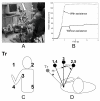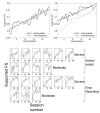Robot-assisted reaching exercise promotes arm movement recovery in chronic hemiparetic stroke: a randomized controlled pilot study
- PMID: 16790067
- PMCID: PMC1550245
- DOI: 10.1186/1743-0003-3-12
Robot-assisted reaching exercise promotes arm movement recovery in chronic hemiparetic stroke: a randomized controlled pilot study
Abstract
Background and purpose: Providing active assistance to complete desired arm movements is a common technique in upper extremity rehabilitation after stroke. Such active assistance may improve recovery by affecting somatosensory input, motor planning, spasticity or soft tissue properties, but it is labor intensive and has not been validated in controlled trials. The purpose of this study was to investigate the effects of robotically administered active-assistive exercise and compare those with free reaching voluntary exercise in improving arm movement ability after chronic stroke.
Methods: Nineteen individuals at least one year post-stroke were randomized into one of two groups. One group performed 24 sessions of active-assistive reaching exercise with a simple robotic device, while a second group performed a task-matched amount of unassisted reaching. The main outcome measures were range and speed of supported arm movement, range, straightness and smoothness of unsupported reaching, and the Rancho Los Amigos Functional Test of Upper Extremity Function.
Results and discussion: There were significant improvements with training for range of motion and velocity of supported reaching, straightness of unsupported reaching, and functional movement ability. These improvements were not significantly different between the two training groups. The group that performed unassisted reaching exercise improved the smoothness of their reaching movements more than the robot-assisted group.
Conclusion: Improvements with both forms of exercise confirmed that repeated, task-related voluntary activation of the damaged motor system is a key stimulus to motor recovery following chronic stroke. Robotically assisting in reaching successfully improved arm movement ability, although it did not provide any detectable, additional value beyond the movement practice that occurred concurrently with it. The inability to detect any additional value of robot-assisted reaching may have been due to this pilot study's limited sample size, the specific diagnoses of the participants, or the inclusion of only individuals with chronic stroke.
Figures



References
-
- Carr JH, Shepherd RB. Neurological Rehabilitation: Optimizing Motor Performance. Oxford: Butterworth Heinemann; 1998.
-
- Lum PS, Burgar CG, Shor PC, Majmundar M, Van der Loos M. Robot-assisted movement training compared with conventional therapy techniques for the rehabilitation of upper-limb motor function after stroke. Archives of Physical Medicine & Rehabilitation. 2002;83:952–959. doi: 10.1053/apmr.2001.33101. - DOI - PubMed
-
- Tremblay F, Malouin F, Richards CL, Dumas F. Effects of prolonged muscle stretch on reflex and voluntary muscle activations in children with spastic cerebral palsy. Scand J Rehabil Med. 1990;22:171–180. - PubMed
-
- Odeen I. Reduction of muscular hypertonus by long-term muscle stretch. Scand J Rehabil Med. 1981;13:93–99. - PubMed
Publication types
Grants and funding
LinkOut - more resources
Full Text Sources
Other Literature Sources
Medical

